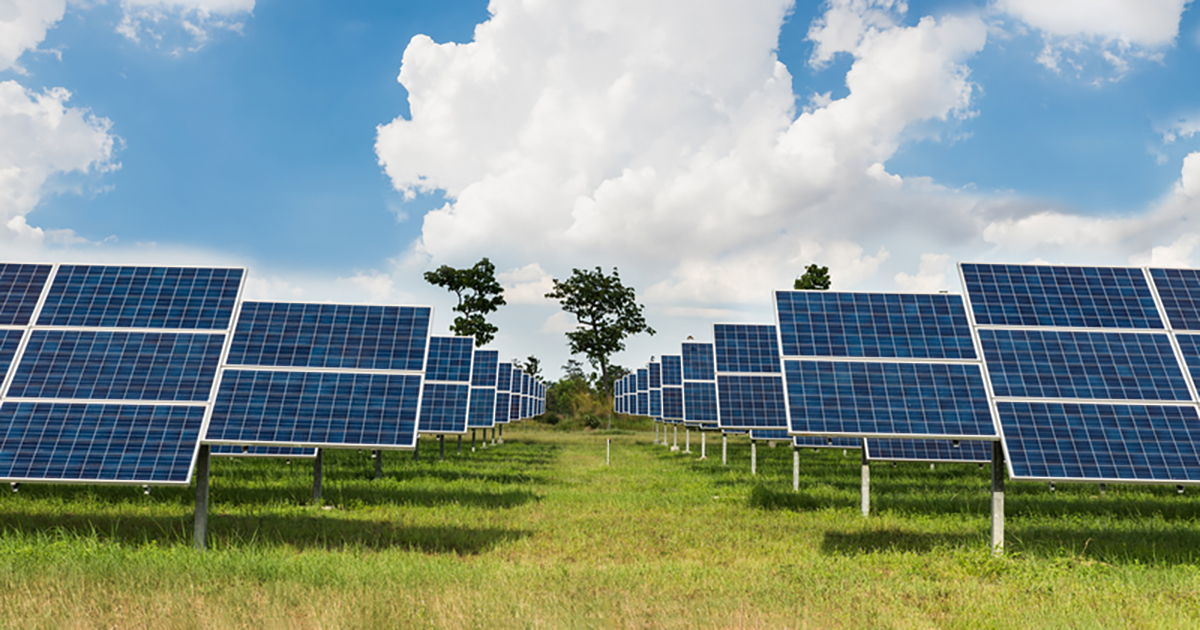Tapping into the power of the sun offers commercial and industrial facilities more control over their utility bills and the ability to operate in a more sustainable fashion. Plummeting prices and improved technology make a host of options available for companies that want to go solar. But they’re left with a lot of information to parse and deliberations to make. We have created this three-part commercial and industrial solar series to shed light on the types of solar installations possible today, important technology considerations, and system financing and cost options available to companies of all sizes.
Part 1
Everything Under the Sun
With technology rapidly progressing in recent decades, especially in the last few years, solar energy systems are cropping up everywhere. Small panels on a neighbor’s roof, a solar carport for electric vehicle charging at the mall, or a pole-mounted system on the side of a highway, solar is quickly gaining in popularity everywhere. There are two major trends driving the solar revolution: system costs and capabilities.
Cost:
Solar systems today are increasingly affordable. The cost of photovoltaic solar panels has dropped from about $10 a watt in 1980 to less than $0.35 a watt today (~97% price decline). Inverter costs have been cut in half in the last decade. Solar companies have lowered their operational and installation costs, creating additional savings.
The cost declines and rapid industry growth continually surprise analysts and even the industry’s most ardent fans. The chart below puts this into stark contrast, showing actual global solar installations (black line) versus the International Energy Agency’s annual estimates (colored lines) which are drastically lower. The sun is rising on the era of incredibly cheap solar.
Solar systems today are increasingly affordable. The cost of photovoltaic solar panels has dropped from about $10 a watt in 1980 to less than $0.35 a watt today (~97% price decline). Inverter costs have been cut in half in the last decade. Solar companies have lowered their operational and installation costs, creating additional savings.
The cost declines and rapid industry growth continually surprise analysts and even the industry’s most ardent fans. The chart below puts this into stark contrast, showing actual global solar installations (black line) versus the International Energy Agency’s annual estimates (colored lines) which are drastically lower. The sun is rising on the era of incredibly cheap solar.

Capability:
Along with the steady march of progress on cost, solar systems (including the related hardware that connects it to a building and the wider grid) are also simultaneously becoming more capable and adaptable.
The classic rooftop solar panels are just the beginning. Newer panels that track the sun throughout the day can maximize energy output. Self-cleaning systems can make solar nearly maintenance free. With smart inverters, solar output can be matched dynamically to load in real time.
No roof space? It might make more sense to float your panels in a retention pond (with the benefit of liquid cooling!). 24/7 operations? Adding the right amount of energy storage means that a facility can run on clean power at night, and near indefinitely should the wider grid go down.
As the overall costs for solar systems have declined, more capable systems have become economically viable. These new capabilities come with additional benefits for system owners and hosts, making the value proposition even more attractive to potential customers.
Along with the steady march of progress on cost, solar systems (including the related hardware that connects it to a building and the wider grid) are also simultaneously becoming more capable and adaptable.
The classic rooftop solar panels are just the beginning. Newer panels that track the sun throughout the day can maximize energy output. Self-cleaning systems can make solar nearly maintenance free. With smart inverters, solar output can be matched dynamically to load in real time.
No roof space? It might make more sense to float your panels in a retention pond (with the benefit of liquid cooling!). 24/7 operations? Adding the right amount of energy storage means that a facility can run on clean power at night, and near indefinitely should the wider grid go down.
As the overall costs for solar systems have declined, more capable systems have become economically viable. These new capabilities come with additional benefits for system owners and hosts, making the value proposition even more attractive to potential customers.
Types of Solar Available
There are many different options available when considering solar power for your business. Here are some of the most common types available today.
Photovoltaic Panels:
Probably the first thing we all think of when someone says solar power. First pioneered in the 1880s, solar panels can be made from a wide range of materials that are able to convert energy from the sun into usable electricity, though silicon-based technology currently dominates the marketplace.
Different kinds of photovoltaic (PV) panels (including monocrystalline, polycrystalline, and thin film) have cost and performance differences that may make one better suited than another for particular installations. PV panels will typically last 25-30 years before being recycled and require little maintenance over their lifetime aside from the occasional cleaning and checkup. Solar panels are also modular, and individual sections can be replaced if damaged (hail, tree branches) or a system expanded should greater need arise in the future.
And no roof, no problem! Solar panels can also be pole-mounted, installed as carports or awnings, floating on a retention pond, or even integrated into building materials like windows. Manufacturers and suppliers have developed all kinds of solutions and aesthetically pleasing options to fit customer needs.
Solar Thermal Systems:
While it is a little more difficult to pin down the first time that humankind harnessed the sun to heat up water, its use in industrial applications can be traced back to at least 1910 when a steam engine was powered by sunlight in the Sahara. Water heating can make up a substantial portion of a building’s energy load, and technology improvements mean you no longer have to be in one of the hottest places on Earth to enjoy the benefits of solar thermal energy.
Industrial process heat accounts for nearly one-third of the nation’s energy use. Industries like hospitals, restaurants, hotels, and recreation properties all use substantial amounts of energy for heating water (as high as 35% of their total demand). Many agricultural and industrial processes also have high demand for hot water, and decarbonizing these sectors is a major climate challenge.
It is estimated that solar thermal systems can provide nearly half of the heat demand of industrial and agricultural food processes. Advanced solar thermal systems can easily heat water to 400°C for a wide range of industrial applications or as carbon-free pre-heating for even more intensive processes. Day-to-day warm water for facilities, showers, space heating, laundry, dishwashing, and yes, even air conditioning, can all be powered by solar thermal systems as well.
The more robust type of solar thermal system is called an ‘evacuated tube’, where the inner element is shielded from the outside air temperature by a vacuum — meaning that it can easily operate in sub-zero temperatures and still produce scalding temperatures from the sun’s radiation. More basic systems are common in warmer climates, where water is passed through thin tubes of metal or black plastic exposed to the sun. Though basic solar thermal systems can’t reach the same high temperatures, they can easily meet day-to-day building needs and are a great fit for hot showers, pools, sauna heating, and other moderate temperature applications.
Technology Integration:
A solar system goes far beyond the type of collector used, and includes a number of other components that each have their own capabilities and benefits.
For example, smart inverters can assess building load and grid signals in real time to provide exact amounts of energy even as clouds pass overhead. Tracking systems can mechanically follow the sun through the sky to maximize output. Integrated heating can take advantage of solar-powered hot water on its way to hotel showers to create radiant floor heating for guests, lowering utility bills.
Additional capabilities may come with additional costs, but they also unlock additional value that may be important to your business. For example, energy storage systems, typically batteries, are of particular value to any business that appreciates keeping the lights on when the grid goes down (i.e., everyone). With the right controls in place, other capabilities can also be monetized by competing in energy markets or participating in utility incentive programs, accelerating the return on investment or even creating a new revenue stream.
There are a number of different options available for commercial and industrial facilities considering solar power. The sum total of components in a solar system can enable many different benefits and can be customized in multiple ways to meet the needs of customers of all types.
In part two of our solar series we will explore technical considerations and benefits important for commercial and industrial facilities.
Photovoltaic Panels:
Probably the first thing we all think of when someone says solar power. First pioneered in the 1880s, solar panels can be made from a wide range of materials that are able to convert energy from the sun into usable electricity, though silicon-based technology currently dominates the marketplace.
Different kinds of photovoltaic (PV) panels (including monocrystalline, polycrystalline, and thin film) have cost and performance differences that may make one better suited than another for particular installations. PV panels will typically last 25-30 years before being recycled and require little maintenance over their lifetime aside from the occasional cleaning and checkup. Solar panels are also modular, and individual sections can be replaced if damaged (hail, tree branches) or a system expanded should greater need arise in the future.
And no roof, no problem! Solar panels can also be pole-mounted, installed as carports or awnings, floating on a retention pond, or even integrated into building materials like windows. Manufacturers and suppliers have developed all kinds of solutions and aesthetically pleasing options to fit customer needs.
Solar Thermal Systems:
While it is a little more difficult to pin down the first time that humankind harnessed the sun to heat up water, its use in industrial applications can be traced back to at least 1910 when a steam engine was powered by sunlight in the Sahara. Water heating can make up a substantial portion of a building’s energy load, and technology improvements mean you no longer have to be in one of the hottest places on Earth to enjoy the benefits of solar thermal energy.
Industrial process heat accounts for nearly one-third of the nation’s energy use. Industries like hospitals, restaurants, hotels, and recreation properties all use substantial amounts of energy for heating water (as high as 35% of their total demand). Many agricultural and industrial processes also have high demand for hot water, and decarbonizing these sectors is a major climate challenge.
It is estimated that solar thermal systems can provide nearly half of the heat demand of industrial and agricultural food processes. Advanced solar thermal systems can easily heat water to 400°C for a wide range of industrial applications or as carbon-free pre-heating for even more intensive processes. Day-to-day warm water for facilities, showers, space heating, laundry, dishwashing, and yes, even air conditioning, can all be powered by solar thermal systems as well.
The more robust type of solar thermal system is called an ‘evacuated tube’, where the inner element is shielded from the outside air temperature by a vacuum — meaning that it can easily operate in sub-zero temperatures and still produce scalding temperatures from the sun’s radiation. More basic systems are common in warmer climates, where water is passed through thin tubes of metal or black plastic exposed to the sun. Though basic solar thermal systems can’t reach the same high temperatures, they can easily meet day-to-day building needs and are a great fit for hot showers, pools, sauna heating, and other moderate temperature applications.
Technology Integration:
A solar system goes far beyond the type of collector used, and includes a number of other components that each have their own capabilities and benefits.
For example, smart inverters can assess building load and grid signals in real time to provide exact amounts of energy even as clouds pass overhead. Tracking systems can mechanically follow the sun through the sky to maximize output. Integrated heating can take advantage of solar-powered hot water on its way to hotel showers to create radiant floor heating for guests, lowering utility bills.
Additional capabilities may come with additional costs, but they also unlock additional value that may be important to your business. For example, energy storage systems, typically batteries, are of particular value to any business that appreciates keeping the lights on when the grid goes down (i.e., everyone). With the right controls in place, other capabilities can also be monetized by competing in energy markets or participating in utility incentive programs, accelerating the return on investment or even creating a new revenue stream.
There are a number of different options available for commercial and industrial facilities considering solar power. The sum total of components in a solar system can enable many different benefits and can be customized in multiple ways to meet the needs of customers of all types.
In part two of our solar series we will explore technical considerations and benefits important for commercial and industrial facilities.





